We are re-thinking IN-network, security and monitoring ICT-infrastructure for your business and residential location!
Intelligent network and security/monitoring infrastructure for your business and home—internationally connected and monitored.
Due to the impacts of globalization and the economic and political changes in many countries, businesses and people are increasingly working internationally.
This means they are increasingly operating from abroad and collaborating with international partners and customers.
These developments reinforce the need for economic and technical internationalization, which highlights the importance of a reliable international ICT infrastructure for both individuals and businesses.
Given the economic growth, strong economic master plans, forward-looking technology promotion, and successful country-oriented technology introductions, the inevitable emergence of new living centers, commercial metropolises, and financial hubs, unique tourist attractions, and future affordable and stable energy supply solutions in various countries (including UAE, China, USA, etc.), as well as the resulting changed conditions of living/working, businesses (established companies, startups, investors) and people (entrepreneurs, personalities) must rethink and technically upgrade internationally.
It is therefore necessary, and already clearly evident in the global economy, to intensively focus on economic, political, entrepreneur- and people-friendly, and future-oriented internationalization. In this context, an international, professional, and stable network and security/monitoring infrastructure plays a crucial role for businesses and individuals.
Against the backdrop of these requirements/developments, a technically stable cross-border ICT network & security/monitoring infrastructure must be established, expanded, or the existing system economically and technically optimized for people and businesses/entrepreneurs from all industries.
Our international ICT expert team advises and supports companies and personalities in the selection, installation, integration, and configuration of international ICT network and security/monitoring infrastructure for both business and residential purposes, aiming to SECURE/MONITOR data and assets.
We are happy to work with you and/or your architect/construction company to determine your personal network and security requirements, taking into account your wishes/goals and the local conditions of your location/property.
In addition, we will create a customized network and security/monitoring concept for your professional and private property, even internationally.
Our consulting service is customer-friendly, free of charge, and non-binding!
Everything from a single source and with absolute DISCRETION:
From analysis, planning, and sales to assembly, installation, integration, configuration, and sustainable technical administration—our professional team of ICT experts is at your side with trust.
SECURING/MONITORING your ICT network infrastructure (private and for your business) and your assets/property is our job!
We are re-thinking and building ICT-infrastructure for your business and residential location
We are re-thinking and building ICT infrastructure for your business and residential locations.
We are ICT experts for professional international WAN/LAN networks, wireless access point systems, and security/monitoring infrastructure/systems for business and private locations.
Our goal is to protect entrepreneurs, companies, and personalities with tailored international security/monitoring solutions.
Building the future of your IN-network, security and monitoring infrastructure!
Hardware Setup Installation System Integration Configuration
-
WAN / LAN
into the IN network infrastructure -
Wireless-Access-Point
into the IN network infrastructure -
Security / Surveillance Infrastructure / Systems
(cameras, access controls, etc.) into the IN network infrastructure -
Notebooks and other technical systems
into the WAN/LAN and security/surveillance IN network infrastructure
Procurement of equipment for
- WAN / LAN
- Wireless-Access-Point
- Security / Surveillance Infrastructure / Systems
- Notebooks / Workstations
- Battery storage for power supply and backup
Services
-
Inventory / documentation of the WAN / LAN,
wireless access points and security / surveillance
infrastructure / systems as well as the notebooks
into inventory management software -
Control app for monitoring your
security / surveillance systems -
Technical administration of WAN/LAN,
wireless access points and security / surveillance
infrastructure / systems as well as notebook
configuration (upgrades, updates, quality check,
etc.)
Implementation of your future network, security and monitoring infrastructure for business and privat locations!
We rely on the powerful and innovative technology partner Ubiquiti Networks
Security Cameras
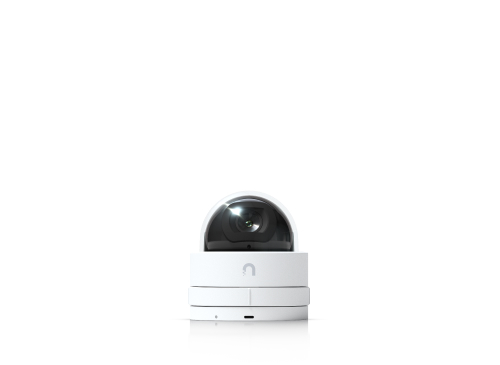
G5 Dome Ultra
Redefining the compactness of dome cameras.
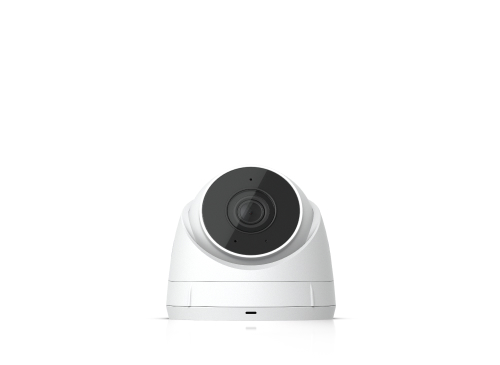
G5 Turm Ultra
Weatherproof with long-range night vision.
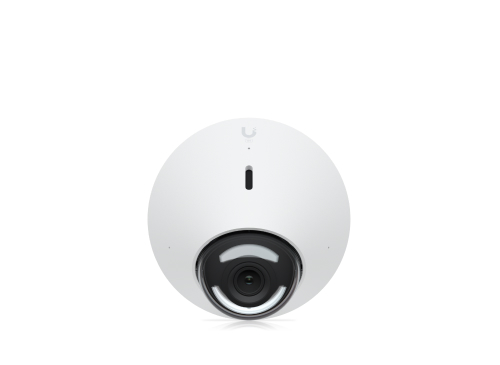
G5 Dome
Discreet with wide coverage.
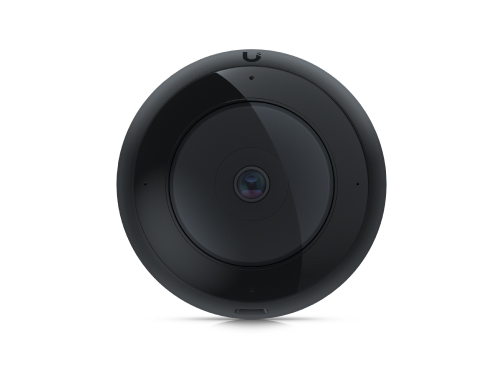
AI 360
Panoramic coverage with digital PTZ control.
Local Storage

UNVR Enterprise
Enterprise scalability and redundancy, ideal for large organizations.
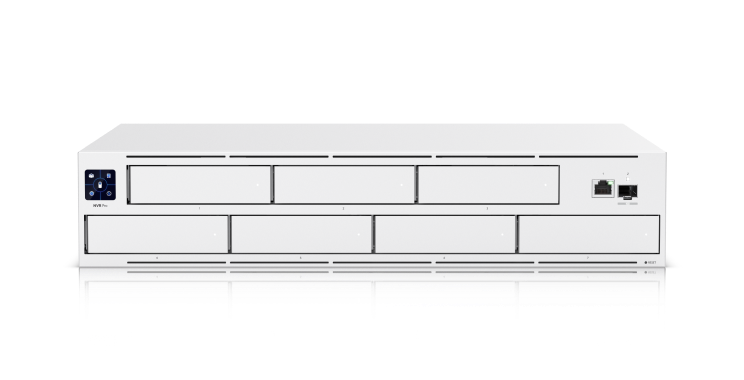
UNVR Pro
Performance and scalability at the enterprise level.
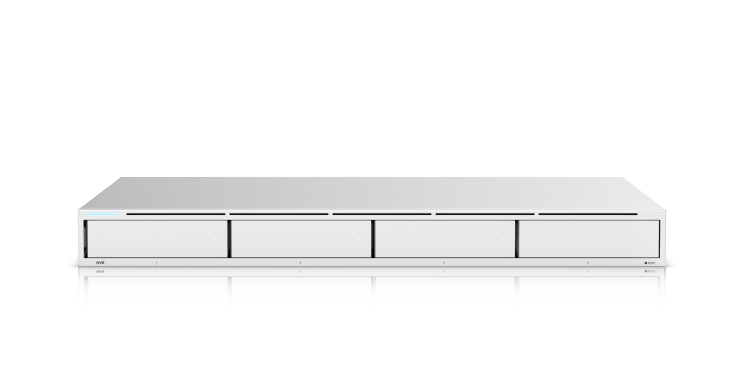
UNVR Standard
Excellent performance for businesses of all sizes.
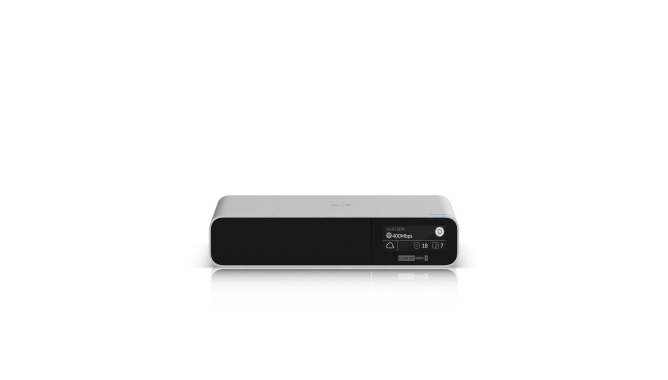
CloudKey+
Compact UniFi console, ideal for entry-level deployments.
WLAN

U7 Pro Max
High-density UniFi 7
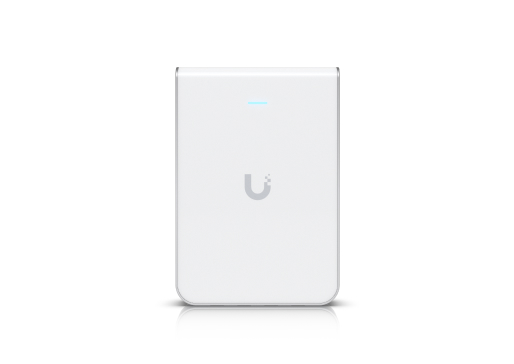
U7 Pro Wall
All the benefits of UniFi 7 and 6 GHz, tailored for interior design.

U7 Outdoor
Integrated directional antenna for long-range coverage.
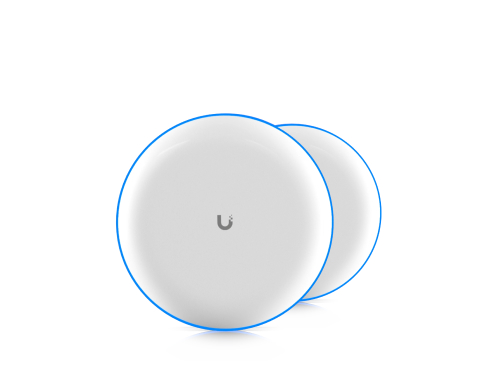
Building Bridge
High-performance wireless point-to-point bridge.
Professionell support for network & security
ICT-infrastructure
for your business and home base location!
- Distribution of Ubiquiti products with project prices
-
Analysis & consulting
(including electrical installation planning and on-site cabling, description of a service catalog based on customer requirements and the future security/monitoring concept, etc.) -
Concept & strategy
(including electrical installation planning and on-site cabling, description of a service catalog based on customer requirements and the future security/monitoring concept, etc.) -
Project management & realization
(including the execution of electrical installation and cabling, etc.) -
Technical administration & operation*
of WAN/LAN, wireless access points, and security/monitoring infrastructure/systems, as well as notebook configuration - Quality check*
- Upgrades, updates & update checks*
- Training for Ubiquiti products
*According to individually agreed intervals, permanently and/or on request.
We work closely with your architect, construction company, craftsmen, and you personally as your universal ICT expert/partner for IN-network and security/monitoring infrastructure/systems.
Our success-oriented collaboration with you is based on clear goals, a professional working method, and a “hand in hand” approach.
Automated Alarm Calls via Voice Bot – with Confirmation
Our intelligent IN platform is triggered by security-relevant events, such as the detection of a person by a video surveillance system, and automatically initiates an outbound call to predefined target persons.
These individuals are informed about the incident by a dynamic voice bot and can confirm the alarm by entering a DTMF code (key press).
If no confirmation is received within a defined time window (default: 1 minute), the alarm call is automatically retriggered – and repeated until a confirmation is received.
This ensures maximum reachability and immediate responsiveness in the event of an incident.
Key Benefits at a Glance:
- Automated outbound calls triggered by camera detection
- Voice bot provides clear and targeted incident information
- Alarm confirmation via keypress (DTMF)
- Repeated call loops if confirmation is missing
- Callflow & voice content customizable anytime via web interface ("Cockpit")
- Optional email notifications for alarms
Technical Process in Detail:
When the push URL is triggered, our IN platform automatically initiates an outbound call, transmits a local emergency number, and informs the recipient via voice bot about the detected event. The integrated multicall system enables simultaneous alerting of multiple target numbers.
If the called party enters the required DTMF code, the alarm is considered confirmed – no further calls are made. If no confirmation occurs, the system will automatically initiate another outbound call after a user-defined delay. This ensures that no alert goes unnoticed.
Our solution is fully customizable – from announcement logic to escalation chain – and can be easily configured via a user-friendly web interface.
Whitepaper Video Surveillance Everything you need to know!
The right analysis and planning are crucial for the success of a video surveillance system.
To ensure that a video surveillance system operates reliably and professionally, the topic should be considered as early as the planning phase of new construction or renovation, as well as during the (re)design of business premises (at the site).
For a video surveillance system, a separate cable route (network cable) is required for each camera location. If the cabling work is not carried out in-house or not planned for during the electrical installation, additional costs will arise for the company commissioned to carry out the necessary cabling.
It is also advisable to consider potential camera viewing angles in advance when designing the property (e.g. garden layout) and the building itself, to avoid blind spots that could later pose security risks. These areas could otherwise become target points for burglary or vandalism.
The following information outlines the individual planning steps in detail:
and integration into the network infrastructure
Cabling to implement the network, security, and surveillance infrastructure/systems
Integration
Setup of a video surveillance system for your own home and/or company premises for the purpose of security and monitoring.
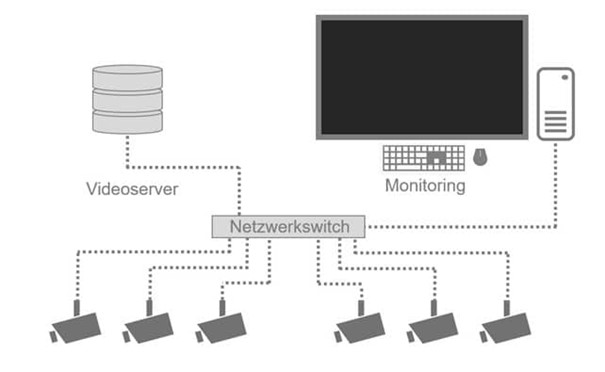
Here is the translated text with formatting preserved:
The basic setup of an IP-based video surveillance system includes, in addition to the surveillance cameras, a network switch, which simultaneously supplies power to the cameras, a video server (NVR = Network Video Recorder) for storing the video footage, as well as a workstation for evaluating the video material. This setup can be expanded with additional components depending on the size of the video surveillance system.
The core of the video surveillance system is the network video recorder (NVR). This device processes the recordings and prepares them for the integrated video management software. Depending on the application area and complexity, there are different variants of the NVR. Below, you will find an illustration of a typical network video recorder.
Proper cable installation of the premises / property / building is a prerequisite and therefore absolutely necessary.
In the past, video surveillance systems were interconnected using coaxial cables in a star topology. Coaxial cables consist of a very thin inner conductor (core) and an outer shield. The video signal was transmitted in analog form through the cable and converted into an image at the endpoint.
The problem with coaxial cables is that this type of cable can be susceptible to electromagnetic interference. As a result, disrupted video images may occur. With the advancement of digitalization, video surveillance technology has shifted from analog systems to digital systems (IP systems). This shift required new types of cables, which I will examine in more detail below.
Which cable is up to date and required – “everything runs on IP” now?
Modern IP-based video surveillance systems are connected using standard network cables, which are also commonly used for internet communication. These cables are referred to as CAT cables in technical terminology. CAT stands for Category and is followed by a number indicating the cable category. The different categories vary in their shielding. The higher the shielding, the more bandwidth the cable can transmit.
For a professional video surveillance system, each camera location should be connected using CAT 7 network cables. The bandwidth demands of IP surveillance systems are often underestimated. Using CAT 7 ensures that the IP-based network infrastructure has sufficient capacity reserves for the future.
Can existing cables be reused?
If a building is already equipped with a video surveillance system, it can be checked whether the existing cabling can be reused. Analog coaxial cables in particular can often be reused with the help of a media converter. This requires a detailed analysis by a professional company.
The digital IP signal is transmitted via the analog coaxial cable using a converter and then converted back into a digital IP signal at the endpoint. These media converters enable straightforward transmission without major configuration effort. The same applies to transmission via existing telecommunications cables. In older buildings, legacy cable runs can often still be used, provided they allow signal transmission via media converters. However, these converters are not particularly cost-effective and add another component to the overall system that may fail.
Alternatively, IP signals can also be transmitted via standard electrical wiring. This requires suitable transmitters and receivers to be plugged into existing power outlets. The sender and receiver can then transmit IP signals through the standard electrical wiring, consisting of power, protective, and neutral conductors.
In summary, it can be stated that transmission via existing cabling is possible. However, since a video surveillance system is a security-relevant system, it is recommended to run the cabling for a video surveillance system separately and independently of other systems. Especially in terms of operational reliability (e.g. power outage), it is essential to ensure that the systems operate independently and, ideally, are supported by a separate power supply (via UPS and/or battery).
Wi-Fi connections as an alternative to complex cable installation.
We are often asked whether the effort of laying cables can be avoided and surveillance cameras can simply be operated via a Wi-Fi connection. There are many different video surveillance systems on the market and online that communicate via Wi-Fi. In principle, this technology is sufficient for some areas of application. However, users should be aware that Wi-Fi-connected cameras can easily be disrupted by a jamming signal on the same frequency as the Wi-Fi. Furthermore, the Wi-Fi signal must have sufficient range to reliably provide a stable connection to surveillance cameras around the property.
Even though Wi-Fi-based surveillance cameras do not require data cables, they still need an external power supply. This significantly reduces operational reliability, as either battery operation is required or an exposed power line must be routed to the camera. For a professional video surveillance system, this type of operation is generally not suitable due to the lack of availability and operational reliability.
The security/surveillance concept should be precisely tailored to the full requirements of the individuals or companies involved. For this reason, it is recommended to have a professional company analyze the existing power/network infrastructure of the property and location (what risks exist at the site) and to discuss with them your requirements for the security purpose.
Safety should always come first!
How are the surveillance cameras powered?
IP-based surveillance systems can be powered via CAT cables. Power supply over CAT cables is also known as PoE (Power over Ethernet). The advantage of this power supply lies in the dual use of the network cable for both data and power. No additional power lines are needed for the surveillance cameras. In addition, the cameras can be centrally powered from a single PoE switch.
Where should I position the surveillance cameras?
The correct positioning of surveillance cameras determines the effectiveness of the video surveillance system. Surveillance cameras should be positioned in such a way that maintenance is possible at any time, but potential intruders have no chance to damage the camera. Consequently, the camera should never be installed at reach height (at least 3 meters). In addition, the cabling to the camera should be laid inaccessibly along the exterior wall of the building. The camera’s field of view should be free of leaves or branches at all times of the year, as excessive movement in the image otherwise increases the camera’s streaming load. Video analysis functions in particular are heavily affected by moving branches or bushes.
Integration of the video system with IoT devices, smart home, or intruder alarm system.
Modern IP-based video surveillance systems offer various interfaces for connecting with IoT or smart home devices. Specifically, professional video servers allow switching via I/O contacts both through software and hardware. Using this I/O interface, it is possible to control other smart home devices (such as lamps, motion sensors, or complete control units for garden systems). The switching command can be triggered via the control interface of the video surveillance system, or the smart home system sends the switching command to the video system.
Example:
The video sensor of the video surveillance system detects movement in the garden. This triggers the I/O contact via software and activates the entire garden lighting. Manual contact switching via remote access to the video surveillance system is also possible. Additionally, a door or window contact from the intruder alarm system can activate the video recording of a surveillance camera. The reverse process is also conceivable.
Conclusion on planning a video surveillance system:
In summary, it becomes clear that the analysis and conceptual planning of a professional video surveillance system
must take into account a wide range of technical conditions and the customer’s specific requirements.
A video surveillance system is planned and installed individually based on the local conditions and the desired
security/surveillance purpose, and integrated into the private/professional network in practice.
By involving a specialized company, it is possible to draw on expertise in the analysis, planning, installation,
and commissioning of the video surveillance system. After all, in a critical situation, a reliable surveillance
system must be in place. At this point, it should be emphasized that the company responsible for setting up
or integrating the video surveillance system should be trustworthy and discreet.
Quality differences between video surveillance systems
The internet offers a wide range of video surveillance systems. These come in a variety of price ranges.
Below, you will learn what differences exist and how to recognize whether a product is of good quality.
How can I recognize high-quality video surveillance systems?
Higher-quality products in the field of video surveillance are characterized by the use of high-grade materials,
durable electronic components, and individually configurable software. Surveillance cameras exposed to weather
conditions must be especially resistant to ensure long-term operation.
Example:
The protective glass of a low-cost surveillance camera shows “milky” spots after only a short time in outdoor use.
As a result, the field of view is limited. UV radiation has severely damaged the material over time, making it
necessary to replace the camera. Another example is a camera that, according to the manufacturer, delivers an
optimal image. In practice, however, the image is unusable due to lighting conditions and varying daylight,
because the camera cannot be adjusted to local conditions via software.
Note:
High-quality products can be identified by the following features – and especially by reading the fine print.
Here are some examples for comparing products:
Does the product come with a meaningful data sheet?
What light sensitivity does the offered surveillance camera have?
(Stated in lux – the lower the value, the more light-sensitive the camera is)Is power supply via PoE possible?
(Battery-powered models are not suitable for professional use)Can the network settings of the surveillance camera be individually configured?
What security features can be configured?
Does the surveillance camera comply with the General Data Protection Regulation (GDPR)?
What services and warranty options are offered for the product?
Do-it-yourself or consult a professional company?
- Can the purchased products fulfill the manufacturer's promises?
- Does the surveillance camera have the same image quality at night?
- Can I view meaningful sample images from the manufacturer?
- Are there test reports or long-term test information?
- The basic question is: How does the product behave after years of 24/7 continuous use in all weather conditions?
- Do I get support from the supplier for setting up the devices?
- What happens if a device is defective or non-functional after installation? Are there warranty or goodwill solutions?
- Can the network settings be configured, and do I have sufficient knowledge to create a secure network?
- Can I configure my internet router for external access to the video system?
- Private internet connections often have daily changing IP addresses to avoid double assignments in the network.
- Therefore, the configuration of DynDNS is required.
- Do I have sufficient experience to set the field of view and image settings of the surveillance cameras to achieve an optimal image in all lighting conditions?
- Do I have enough knowledge to configure the video server and network switch to make external attacks impossible?
- Will I still get spare parts after years of operation, or can I expand the video system with additional surveillance cameras?
- Can I comply with the General Data Protection Regulation with the purchased DIY video system?
The question of whether to set up a video surveillance system yourself or to consult a professional company
is one that each person must decide for themselves. When installing on your own, there is a risk that the system
may not be installed/configured properly, which could lead to violations of data protection regulations or compromise privacy.
If the goal is to install a professional and more secure video surveillance system, it is strongly recommended
to consult a professional company. Since a video surveillance system must function reliably in a real emergency,
it is advisable to have the technical possibilities and local conditions reviewed in advance by an expert advisor.
If you decide on a do-it-yourself solution, you should consider the following points:
You should be able to answer these questions for yourself if you want to set up a secure and data protection-compliant video surveillance system.
In the following section, we will look at the legal framework for video surveillance.
IMPORTANT:
This is not legal advice, but only general guidance. For binding legal advice and action recommendations,
please consult a qualified attorney.
In Germany, video surveillance systems are subject to specific legal regulations. The following chapters provide a clear overview of the most common requirements.
When is video surveillance allowed?
In general, video surveillance is allowed in Germany. However, it must be distinguished for what purpose the surveillance serves. The law differentiates between private and public areas.
Legal framework for video surveillance in private areas
Video surveillance is generally permitted in private areas. The condition for this is that all involved individuals agree to the surveillance. The private area includes the interior of a building/object that is not accessible to uninvolved persons. In addition, the private exterior — i.e. a private property — can be secured with video surveillance.
It must be ensured that surveillance cameras do not monitor areas beyond the property boundaries.
The surveillance camera must clearly not cover areas outside the property.
This means that the lens must be visibly not directed toward public or external areas.
Example:
In an apartment building, residents want to install a video system in the entrance area (hallway).
Legally, the installation is permitted if all residents of the house agree to the measure.
This is considered a private area, and surveillance of the sidewalk in front of the house is not the primary concern.
Installing a camera in front of the entrance is only permitted if no public sidewalk falls within the camera’s field of view.
Door intercom systems with integrated camera units may still be installed, as these cameras are only temporary
and do not represent a continuous video recording field.
Legal framework for video surveillance in public areas
In public areas, surveillance is subject to general data protection regulations and the respective state or municipal law. In Germany, public places cannot be monitored without a justifiable reason. In most cases, public surveillance can be justified by increasing security and reducing crime.
What notice obligations must be observed?
As soon as an area is monitored that could be entered by uninvolved persons, it is necessary to place a notice sign. This, of course, only applies if this area is freely accessible and not enclosed by barriers such as a fence. A notice-obligatory area could be, for example, a company premises that is regularly entered by parcel deliverers or customers. The premises may be privately owned but are regularly accessed without obstacles by uninvolved persons.
The law provides that the notice must be given before entering the monitored area. Therefore, this notice sign must be placed at the property entrance. Furthermore, the sign should be clear and provide sufficient information about the reason for the surveillance and further information. The keyword is “notice sign,” which must be visibly placed according to the law.
How long can image recording take place?
German laws contain no explicit regulations on this matter. Neither the Federal Data Protection Act nor the GDPR specify the duration of video recordings. Therefore, general data protection principles apply, stating that video footage may only be stored as long as necessary to fulfill its purpose. In practice, this means that after an incident, enough time must remain—accounting for weekends or public holidays—to secure the footage.
Example:
An incident occurs on a company premises on Friday afternoon. The authorized employee, however, is already off duty and won’t be able to secure the footage until Monday morning. In this case, a minimum recording duration of 72 hours would be justifiable.
Are audio recordings allowed alongside image recordings?
In Germany, it is not permitted to record sound alongside image recordings. Surveillance cameras with an integrated microphone do not withstand a data protection review.
Conclusion on video surveillance:
In summary, it can be said that there are many aspects to consider when planning and technically implementing a video surveillance system. Individuals with sufficient technical know-how can set up and configure a video surveillance system on their own.
However, it is recommended to carefully analyze the data sheets of suitable products before purchasing, to ensure that the desired results can be achieved after the system is installed. Alternatively, there is the option of consulting a qualified specialist company, which can assist with designing the appropriate video surveillance system, as well as with installation and configuration.
If there are specific requirements (such as clear security/surveillance purposes) and uncertain technical conditions, a specialist company for video surveillance systems and/or network installations should be involved in selecting the right system and integrating it.
Contact
Would you like to secure your business and private locations (even internationally) with a highly available WAN/LAN network, a professional wireless/security/surveillance infrastructure, or optimize them economically and technically?
Don’t hesitate – we look forward to hearing from you.
We are happy to arrange a consultation with you.
Are you ready for an upgrade?
Christopher Richter
Network & Security Expert
Christopher
Hey, how can I help you today?
Powered by Elementor